Abstract
The analysis of records of amoebal infection in various hospitals in Kilimanjaro indicated frequent occurrence of amebiasis. The population over the age of five years had higher rate of amoebal infection compared to less than that of a five-year-old population; however, both age groups had similar patterns of amebiasis during January 1999 to June 2001. To investigate misdiagnosis of amebiasis, 226 patients (passive cases) in three hospitals and 616 individuals (active cases) from three different localities in Kilimanjaro were examined. In passive cases, the prevalences of Entamoeba histolytica and Entamoeba dispar were 1% and 7.3%, respectively. Among active cases, 1% were infected with E. histolytica, and 15% were infected with E. dispar. There were no significant differences in amoebal infection between the male and female populations. A pool of 842 stool samples was used for diagnosis of E. histolytica and E. dispar by microscopic examination or ELISA kits. The microscopic examination indicated 8.7% amoebal infection; however, using ELISA as the gold standard, the prevalence of histolytica/dispar was 0.8% and 7.4%, respectively. This study indicated that E. dispar infection was 14.5 times more prevalent than E. histolytica infection.
Full text
PDF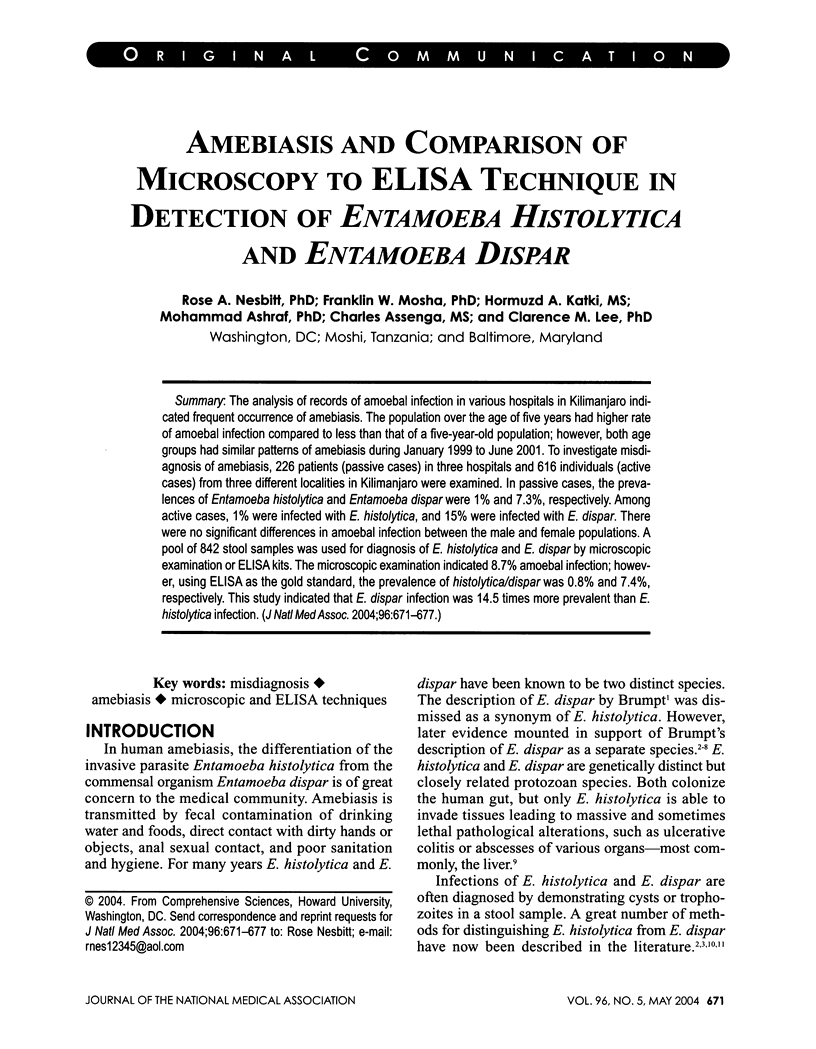
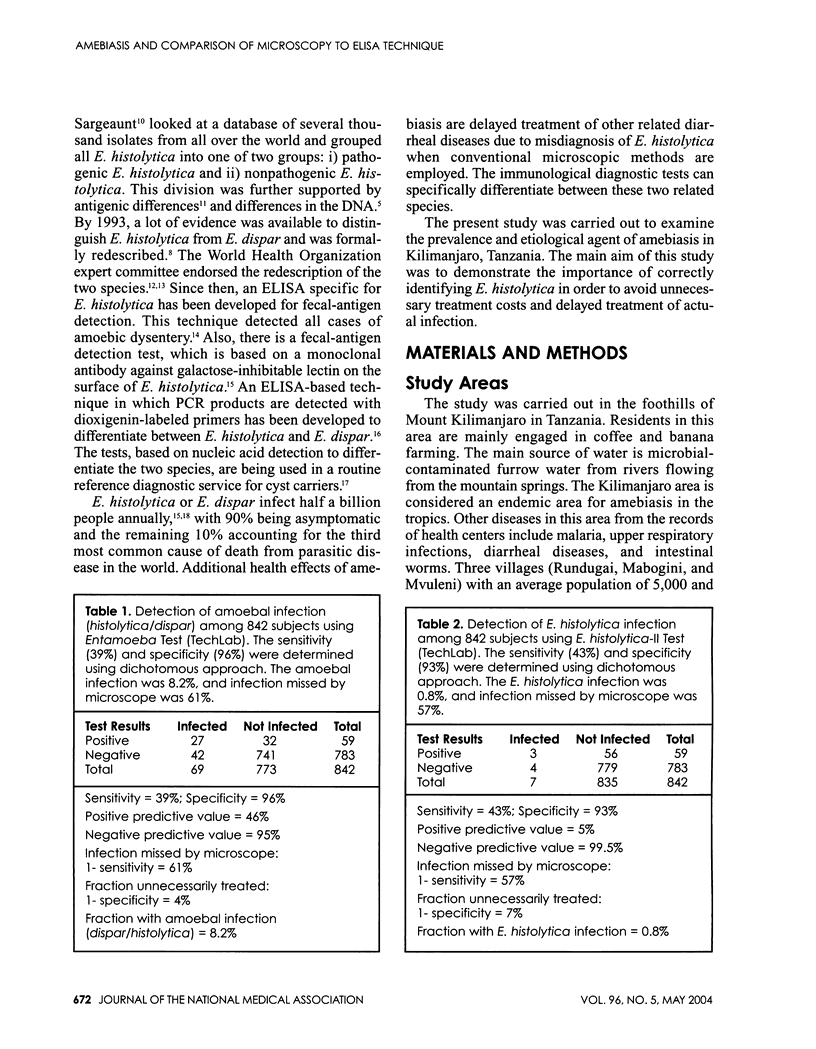
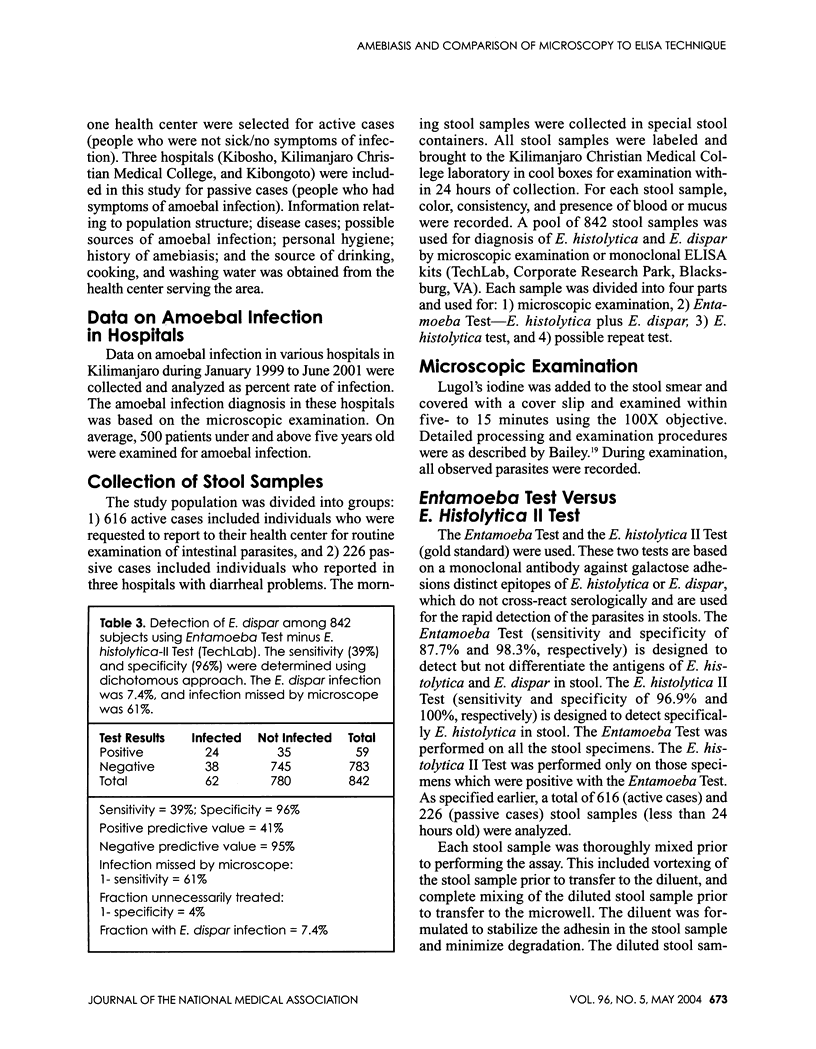
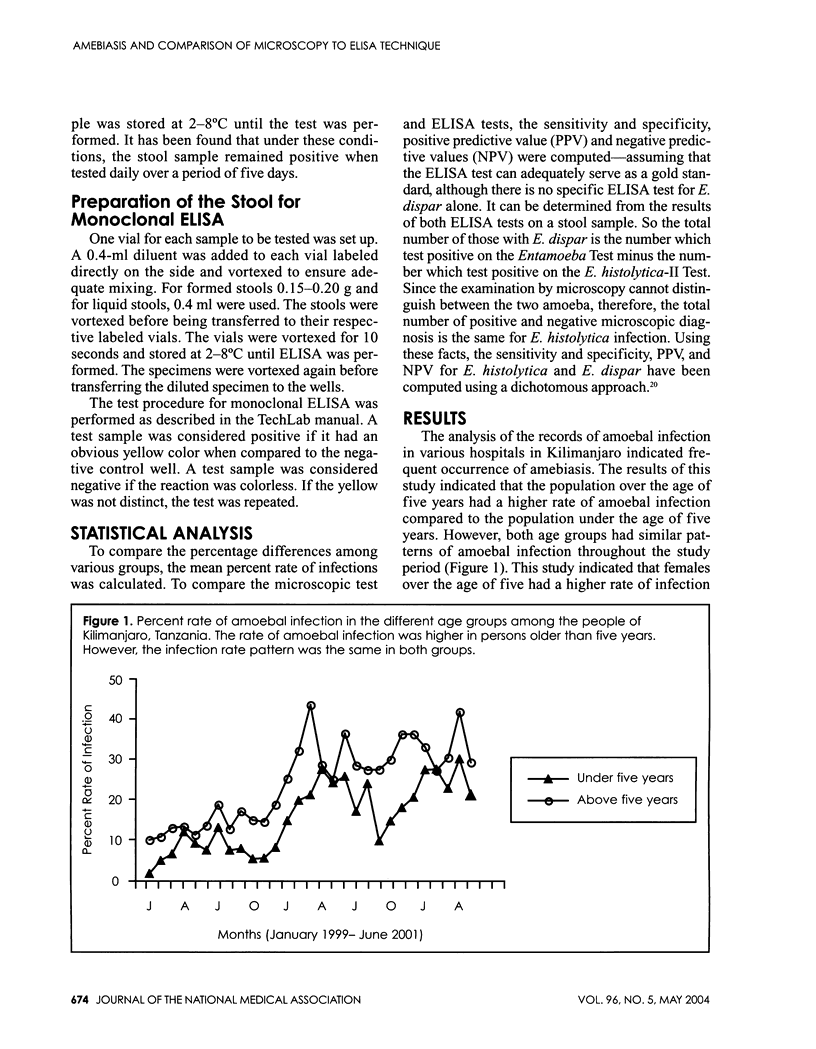
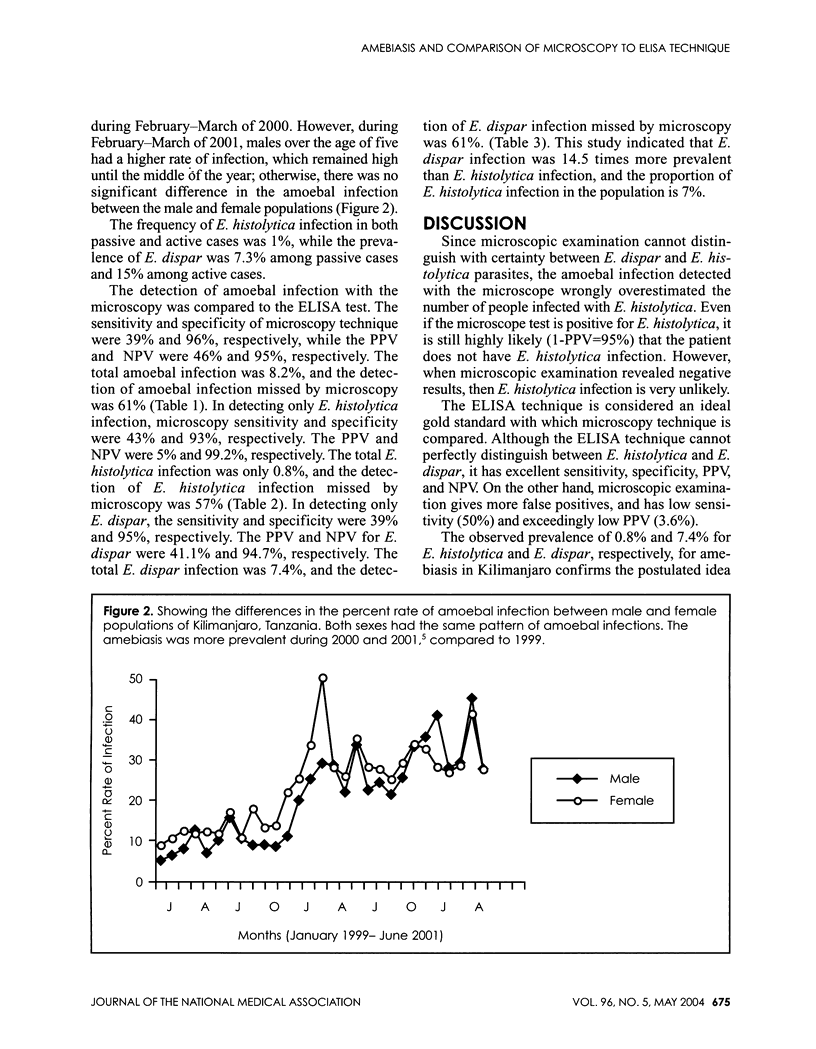
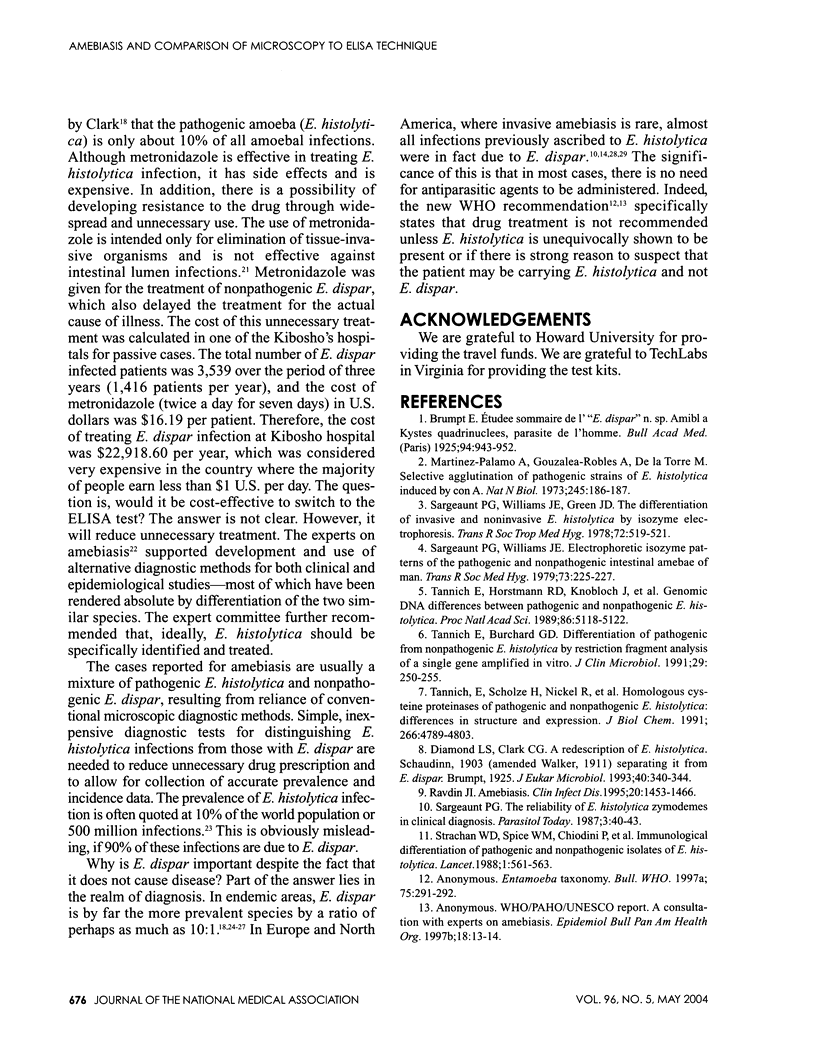
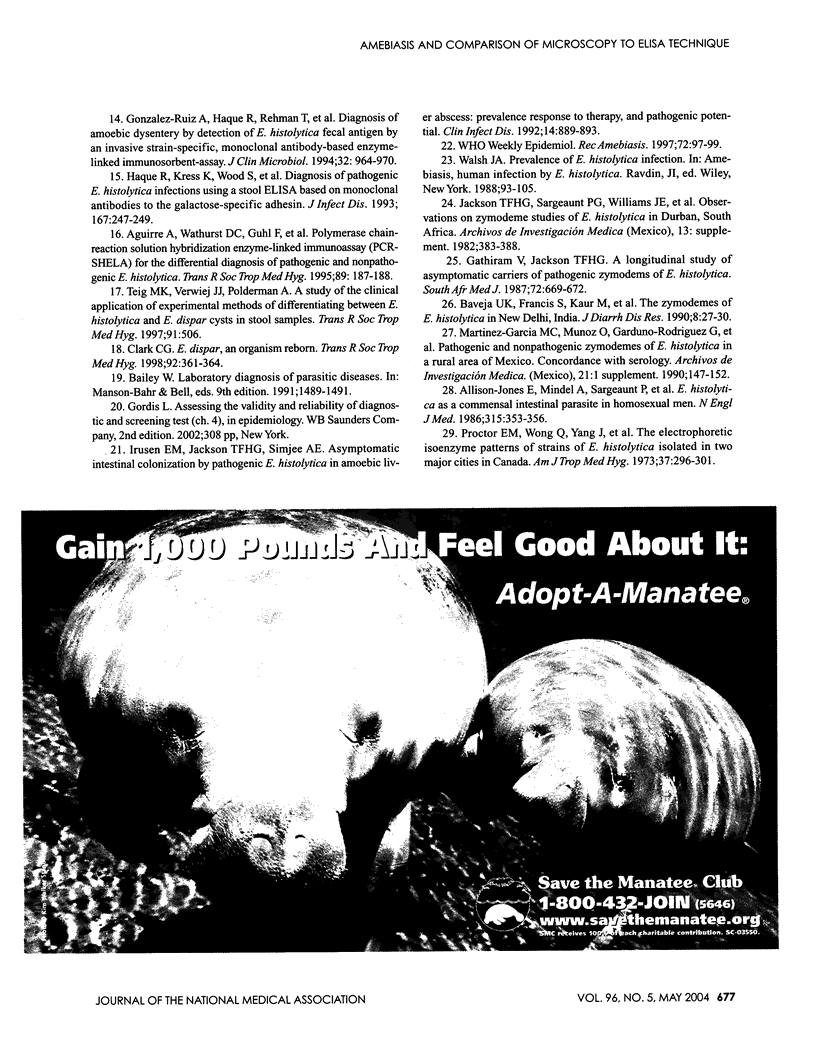
Selected References
These references are in PubMed. This may not be the complete list of references from this article.
- Aguirre A., Warhurst D. C., Guhl F., Frame I. A. Polymerase chain reaction-solution hybridization enzyme-linked immunoassay (PCR-SHELA) for the differential diagnosis of pathogenic and non-pathogenic Entamoeba histolytica. Trans R Soc Trop Med Hyg. 1995 Mar-Apr;89(2):187–188. doi: 10.1016/0035-9203(95)90488-3. [DOI] [PubMed] [Google Scholar]
- Allason-Jones E., Mindel A., Sargeaunt P., Williams P. Entamoeba histolytica as a commensal intestinal parasite in homosexual men. N Engl J Med. 1986 Aug 7;315(6):353–356. doi: 10.1056/NEJM198608073150603. [DOI] [PubMed] [Google Scholar]
- Baveja U. K., Francis S., Kaur M., Agarwal S. K. The zymodemes of Entamoeba histolytica in New Delhi, India. J Diarrhoeal Dis Res. 1990 Mar-Jun;8(1-2):27–30. [PubMed] [Google Scholar]
- Clark C. G. Royal Society of Tropical Medicine and Hygiene meeting at Manson House, London, 19 February 1998. Amoebic disease. Entamoeba dispar, an organism reborn. Trans R Soc Trop Med Hyg. 1998 Jul-Aug;92(4):361–364. doi: 10.1016/s0035-9203(98)91049-5. [DOI] [PubMed] [Google Scholar]
- Diamond L. S., Clark C. G. A redescription of Entamoeba histolytica Schaudinn, 1903 (Emended Walker, 1911) separating it from Entamoeba dispar Brumpt, 1925. J Eukaryot Microbiol. 1993 May-Jun;40(3):340–344. doi: 10.1111/j.1550-7408.1993.tb04926.x. [DOI] [PubMed] [Google Scholar]
- Gathiram V., Jackson T. F. A longitudinal study of asymptomatic carriers of pathogenic zymodemes of Entamoeba histolytica. S Afr Med J. 1987 Nov 21;72(10):669–672. [PubMed] [Google Scholar]
- Gonzalez-Ruiz A., Haque R., Rehman T., Aguirre A., Hall A., Guhl F., Warhurst D. C., Miles M. A. Diagnosis of amebic dysentery by detection of Entamoeba histolytica fecal antigen by an invasive strain-specific, monoclonal antibody-based enzyme-linked immunosorbent assay. J Clin Microbiol. 1994 Apr;32(4):964–970. doi: 10.1128/jcm.32.4.964-970.1994. [DOI] [PMC free article] [PubMed] [Google Scholar]
- Haque R., Kress K., Wood S., Jackson T. F., Lyerly D., Wilkins T., Petri W. A., Jr Diagnosis of pathogenic Entamoeba histolytica infection using a stool ELISA based on monoclonal antibodies to the galactose-specific adhesin. J Infect Dis. 1993 Jan;167(1):247–249. doi: 10.1093/infdis/167.1.247. [DOI] [PubMed] [Google Scholar]
- Irusen E. M., Jackson T. F., Simjee A. E. Asymptomatic intestinal colonization by pathogenic Entamoeba histolytica in amebic liver abscess: prevalence, response to therapy, and pathogenic potential. Clin Infect Dis. 1992 Apr;14(4):889–893. doi: 10.1093/clinids/14.4.889. [DOI] [PubMed] [Google Scholar]
- Martinez-Palomo A., Gonzalez-Robles A., De la Torre M. Selective agglutination of pathogenic strains of Entamoeba histolytica induced con A. Nat New Biol. 1973 Oct 10;245(145):186–187. doi: 10.1038/newbio245186a0. [DOI] [PubMed] [Google Scholar]
- Martínez-García M. C., Muñoz O., Garduño-Rodríguez G., Sánchez-Pares M. E., Valadez-Salazar A., Palacios-Beristain O., Calderón-Segura M., Isibasi-Araujo A., Gutiérrez G. Pathogenic and non-pathogenic zymodemes of Entamoeba histolytica in a rural area of Mexico. Concordance with serology. Arch Invest Med (Mex) 1990;21 (Suppl 1):147–152. [PubMed] [Google Scholar]
- Proctor E. M., Wong Q., Yang J., Keystone J. S. The electrophoretic isoenzyme patterns of strains of Entamoeba histolytica isolated in two major cities in Canada. Am J Trop Med Hyg. 1987 Sep;37(2):296–301. doi: 10.4269/ajtmh.1987.37.296. [DOI] [PubMed] [Google Scholar]
- Ravdin J. I. Amebiasis. Clin Infect Dis. 1995 Jun;20(6):1453–1466. doi: 10.1093/clinids/20.6.1453. [DOI] [PubMed] [Google Scholar]
- Sargeaunt P. G. The reliability of Entamoeba histolytica zymodemes in clinical diagnosis. Parasitol Today. 1987 Feb;3(2):40–37. doi: 10.1016/0169-4758(87)90211-0. [DOI] [PubMed] [Google Scholar]
- Sargeaunt P. G., Williams J. E. Electrophoretic isoenzyme patterns of the pathogenic and non-pathogenic intestinal amoebae of man. Trans R Soc Trop Med Hyg. 1979;73(2):225–227. doi: 10.1016/0035-9203(79)90219-0. [DOI] [PubMed] [Google Scholar]
- Sargeaunt P. G., Williams J. E., Grene J. D. The differentiation of invasive and non-invasive Entamoeba histolytica by isoenzyme electrophoresis. Trans R Soc Trop Med Hyg. 1978;72(5):519–521. doi: 10.1016/0035-9203(78)90174-8. [DOI] [PubMed] [Google Scholar]
- Strachan W. D., Chiodini P. L., Spice W. M., Moody A. H., Ackers J. P. Immunological differentiation of pathogenic and non-pathogenic isolates of Entamoeba histolytica. Lancet. 1988 Mar 12;1(8585):561–563. doi: 10.1016/s0140-6736(88)91355-4. [DOI] [PubMed] [Google Scholar]
- Tannich E., Burchard G. D. Differentiation of pathogenic from nonpathogenic Entamoeba histolytica by restriction fragment analysis of a single gene amplified in vitro. J Clin Microbiol. 1991 Feb;29(2):250–255. doi: 10.1128/jcm.29.2.250-255.1991. [DOI] [PMC free article] [PubMed] [Google Scholar]
- Tannich E., Horstmann R. D., Knobloch J., Arnold H. H. Genomic DNA differences between pathogenic and nonpathogenic Entamoeba histolytica. Proc Natl Acad Sci U S A. 1989 Jul;86(13):5118–5122. doi: 10.1073/pnas.86.13.5118. [DOI] [PMC free article] [PubMed] [Google Scholar]
- Tannich E., Scholze H., Nickel R., Horstmann R. D. Homologous cysteine proteinases of pathogenic and nonpathogenic Entamoeba histolytica. Differences in structure and expression. J Biol Chem. 1991 Mar 15;266(8):4798–4803. [PubMed] [Google Scholar]


